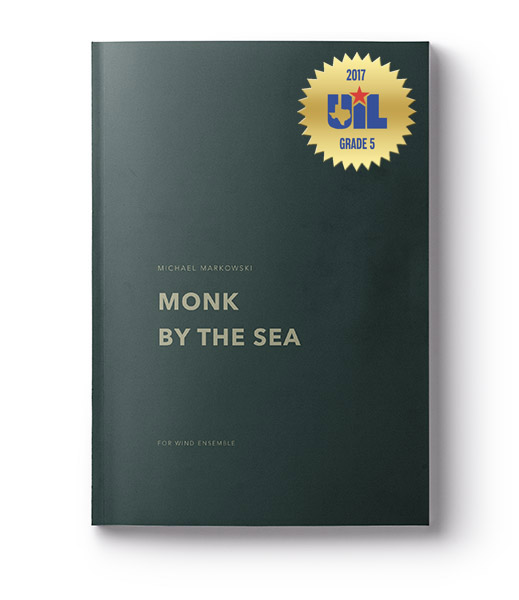Monk by the Sea
Program Note
The German Romantic landscapist Caspar David Friedrich completed his revolutionary work Der Mönch am Meer (The Monk by the Sea), in 1810 after two years of work. The painting, which is one of his most well-known today, was seen as shocking and controversial in its time. The work lacks any traditional framing objects in the foreground, which gives its content a jarring lack of perspective and scope. In the painting, a solitary man cloaked in black stands on a barren outcropping and meditates in observation of a dark expanse of choppy waters that recedes into a murky grey mass of clouds. The bleak image is hauntingly desolate, aside from the distant gulls soaring above the waves and the emergence of a cobalt sky above the reaches of the clouds. Though it failed to receive critical acclaim in Friedrich’s lifetime, it has since been hailed as an early example of abstract painting and has drawn parallels to 20th century works (its segmented, lateral composition has been notably compared to the works of American Expressionist Mark Rothko). In the shared perspective of both the viewer and the monk, it takes on the shape not just of a self-portrait of the artist, but also of anyone who sees the painting, who can imagine themselves in the same isolated world.
Michael Markowski’s Monk by the Sea evokes a similar feeling through the abstraction of sound. Inspired by the painting, Markowski certainly includes several overt foreground references to images included in Friedrich’s work. An oscillation in the lowest register of the piano has the sensation of unstill waters, while an inventive series of sliding artificial harmonics on contrabass mimics the cries of seagulls. The similarities, however, are not limited to sound effects. The lush harmonic language is one of mysterious nostalgia, more reminiscent of mid-20th century neoromantic composers like Howard Hanson and Miklós Rózsa than of more contemporary styles. The effect is one of archetypal familiarity: a timeless connection to the subject matter. Moreover, the cascading layers of thematic material create a murky haze that recalls both the restless boundaries between sky, clouds, and sea and the uncertain sense of wonder observed by the eponymous monk. Compounding this is the ambiguous tonal language, which avoids traditional cadence throughout the piece and sequences so frequently as to create a constant sense of motion. Within the context of this dramatic setting, however, the makeup is surprisingly simple: an insistent repetition of a theme first presented by English horn that falls through seven steps of a diatonic scale before gliding expressively back up a sixth. In doing this, the melody is never completed, but instead cycles incessantly upon itself. As the piece develops, this motive is more frenetically hurried and overlapped through a host of voices. The music ebbs and swells stirringly, reaching an awestricken climax before tapering away into a quiet calm. One final flourish of percussion adds a flash of color—a terminal brushstroke to the sonic canvas.
Commissioned By
Arkansas State University
Arkansas State University – Beebe
Arkansas Tech University
Harding University
Henderson State University
Hendrix College
Ouachita Baptist College
Southern Arkansas University
University of Arkansas
University of Arkansas at Fort Smith
University of Arkansas at Little Rock
University of Arkansas at Monticello
University of Arkansas at Pine Bluff
University of Central Arkansas
Premiere
Monk by the Sea premiered on February 20, 2015 at the 2015 Arkansas School Band and Orchestra Association Conference (Hot Springs, Arkansas) performed by the Arkansas Intercollegiate Band conducted by Gary Hill.
View program here.
Publisher
Markowski Creative (ASCAP)
Instrumentation
Piccolo
Flute 1 & 2
Oboe 1 & 2
English Horn
Bassoon 1 & 2
B-flat Clarinet 1-4
B-flat Bass Clarinet 1 & 2
B-flat Contrabass Clarinet
Alto Saxophone 1 & 2
Tenor Saxophone
Baritone Saxophone
B-flat Trumpet 1-3
Horn 1-4
Trombone 1-4
Euphonium 1 & 2
Tuba 1 & 2
String Bass
Piano
Percussion 1: Timpani, Tam-Tam (with superball mallets, shared)
Percussion 2: Crotales, Suspended China “Trash” Cymbal, Thunder Sheet (shared)
Percussion 3: Vibraphone
Percussion 4: Thunder Sheet (shared), Marimba
Percussion 5: Crystal Glass, Chimes, Suspended Sizzle Cymbal
Percussion 6: Crystal Glass, Finger Cymbals, Tam-Tam (shared), Triangle
Percussion 7: Two Crystal Glasses, Bass Drum
Errata
No known errata.
Year Completed
2015

